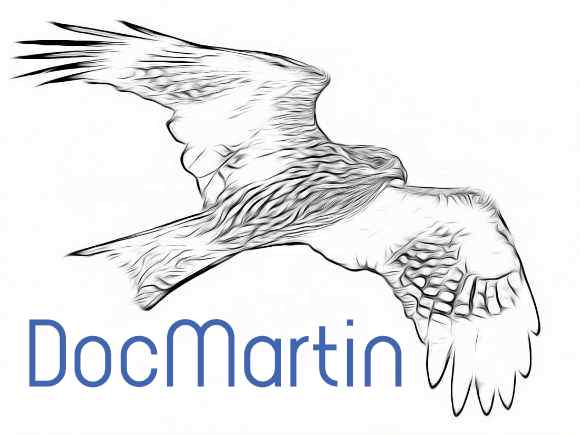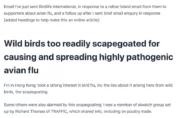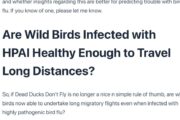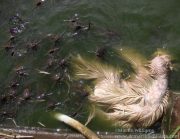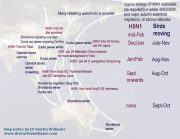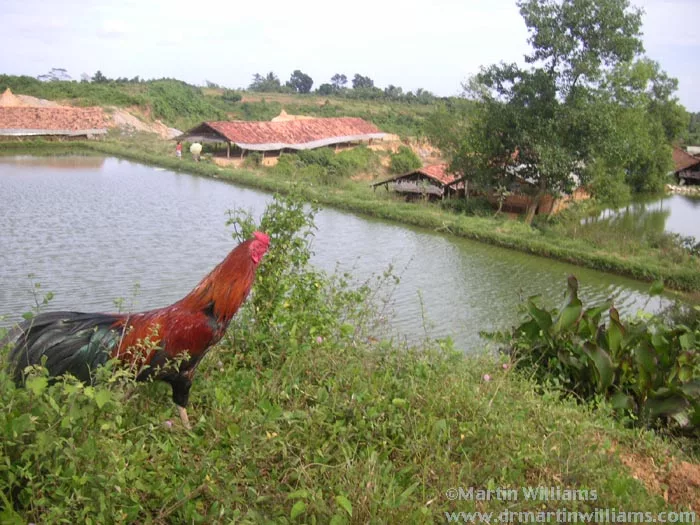Bird Flu – especially H5N1
Update, August 2022: This page originated at time when H5N1 was spreading, causing concern, especially in east Asia; wild birds too often wrongly blamed for spread. See also my page on why migratory birds aren’t behind the bird flu spread in Asia; also forum I’ve started on this site on H5N1 avian flu and wild birds; I’m posting much info there – almost like a blog, and comments/info welcome too. Added a little more recently.
1 Nov 2005: just seen useful article from Canadian Press, Avian flu viruses vary greatly in threat, impact
28 May 2005: After no updates for almost a year, now major bird deaths in Qinghai, northwest China. Follows a June 2004 update, mentioning that new research suggests the H5N1 strain of bird flu – now called genotype Z – is becoming stronger (in mammals) over time. As Nature puts it:Pandemic looms as bird flu mutates. [Later adding – hmmm…..]
Here is a variety of information, with links, on: the New Variant; Species Killed; the New Variant Evolving;Wild Birds Seeming Scary; Wild Exaggerations; Abundant Poultry; Moving the Variant; Wild Bird Flu; Variant’s Va-Voom Via Vaccinations; Sources of Info; Influenza inc Pandemics.
- Bird Flu – especially H5N1
- A New Variant (new variant, of a strain, of a disease!)
- Taking no prisoners – species killed by the New n Nasty H5N1 Variant (Poultry Farm Flu; or Frankenflu!)
- Evolving before our very eyes
- You thought birds were only scary in Hitchcock films?
- Or maybe it’s the things people say that are scary
- Chickens, Chickens Everywhere (well, almost)
- Biosecurity
- Natural Bird Flu, in Wild Birds
- Vaccinations Giving Variant Va-Voom?
- Sources of Info on Bird Flu, especially the New n Nasty H5N1 Variant
- Influenza – sometimes a whole lot worse than a heavy cold
A New Variant (new variant, of a strain, of a disease!)
I emailed a request for info to Dr (Professor) Carol Cardona, a poultry disease specialist at the University of California; received the following response:
“There are many variants of H5N1 virus, some are non-pathogenic and some are highly pathogenic. This particular variant is unusual both for the fact that it can infect humans but also because it can make wild birds, especially ducks, sick. This is completely different than most other avian influenza viruses. The reason I speculated that humans moving birds should not be eliminated as suspects in the spread of this disease is that in my experience sick and dead ducks don’t fly far. [Which I figure is dry humour, inspired title of my other bird flu page.] But, people can very easily move sick birds over many miles. The movements may be legal or illegal but in an outbreak of disease, they usually happen. I don’t think migratory birds can be eliminated as major spreaders but you can never underestimate the ability of humans to move disease.
H5N1 viruses (other variants) have been isolated many times before from all types of birds. How long this one has been around is not known. Most scientists believe it arose around 1997 from a goose virus. [cf info from Henry Niman, below, tracing it to 1996]
I hope this is helpful.
Let me know if you see anything interesting among migratory birds.”
New info, 28 May 2005:
Reported bird deaths from Qinghai, northwest China, rising sharply.
” More than 1,000 bar-headed geese, great black-headed gulls and other birds found this month in the western province of Qinghai died of the H5N1 strain of bird flu, said Jia Youling, director of the Veterinary Bureau of the Agriculture Ministry.”
Deadly bird flu cover-up in China feared
Cormorants dead, too, reports CBC News.
Unprecedented, I believe. As Dr Cardona mentions in email quoted above, bird flu should not be killing wild birds (just v rarely); geese should be well used to wild forms of bird flu. So, seems this is poultry farm flu, rampaging through major waterbird colony.
Haven’t yet seen re how this H5N1 variant infected the birds in the first place. From a farm in Qinghai, or somewhere to south on migration routes? [No bird flu reports from the birds’ main wintering grounds, that I know of; nor from Qinghai either till now…]
Sci-fi scary notions also around, re possible cover-up of bird flu among humans in nw China, with deaths. (Except flu pandemics that cause major death tolls aren’t sci-fi.)
Taking no prisoners – species killed by the New n Nasty H5N1 Variant (Poultry Farm Flu; or Frankenflu!)
Species proven/reported to have been infected by the new H5N1 variant, with at least some individuals dying:
Humans: 22 recent deaths, at least seven previously. Human-to-human transmission is, happily, evidently rare. Though there are concerns the virus could yet evolve – perhaps by swapping genes with human flu – to transmit efficiently between humans, so causing a pandemic. These concerns are especially “interesting” given that recent research suggests the 1918-1919 flu, which was the most deadly pandemic in history, causing over 20 million deaths worldwide (see below), was only a little different to original, avian flu.
Other mammals: zoo clouded leopard (fed on raw chickens), domestic cats.
Birds: domestic chickens, domestic ducks; captive (ornamental) ducks sp, geese sp, black swan greater flamingo; perhaps captive peregrine; wild openbill stork, little egret, grey heron, black-headed gull, crow.
Species proven to have been infected by the new H5N1 variant, with limited or no ill effects:
– as yet, none that I know of. (Vaccinated chickens?? Odd that no pigs reportedly infected?)
17 Feb 2004 08:27:58 GMT
Thailand to test storks for bird flu after some die
BANGKOK, Feb 17 (Reuters) – A few storks have died of bird flu at two bird sanctuaries outside Bangkok and tests are under way to determine how widely the virus has spread, Thai Environment Minister Prapat Panyachatraksa said on Tuesday.
But he said there was no immediate cause for concern and denied saying the H5N1 bird flu virus had killed 800 storks at the sanctuaries, where there are tens of thousands of them.
” I have not said one single word to the effect that 800 birds have died. How could I have made such a careless comment,” he told reporters. “There’s nothing to be worried about.”
” Latest reports yesterday said 17 birds had died out of several tens of thousands. This should be regarded as a small number,” Prapat said.
He added: “We are conducting scientific tests on these storks to determine the extent of bird flu infection.”
Experts say migrating birds are the mostly likely cause of the series of bird flu outbreaks, ravaging poultry flocks in eight Asian countries which have led to the deaths of 14 Vietnamese and six Thais.” [Hmm, “Experts”? – maybe citing FAO, believing the original virus was from wild birds]
Evolving before our very eyes
The following comments by Harvard Medical School bioengineer Dr Henry Niman – posted to a disease outbreaks bulletin board – are on protein and DNA sequences, which indicate that the H5N1 variant can be traced back to goose virus isolated in 1996, but is ever changing.
26 January 26 2004: “The report below [Reuters, domestic ducks dying in sw China] adds to the list of suggestive reports that H5N1 is widespread in China, particularly along its south-east coast. First there was the report of 6 H5N1 positive ducks smuggled onto Taiwan’s Quemoy Island (across from Fujian Province). Next came the report of the peregrine falcon in Hong Kong (next to Guangdong Province) that was H5N1 positive. Now there is the reported on ducks dying and being culled in southern Guangxi Province, very close to northern Vietnam where the first confirmed H5N1 deaths were found and where there has been a reported H5N1 outbreak since July, 2003. In addition, there is the 2003 H5N1 outbreak in Hong Kong, which also traces back to Fujian Province [a family had visited; two returned and were ill with bird flu, one dying; another family member died in China of “respiratory disease”, no tests done].
“Thus, it appears that locations outside of southeastern China have been battling H5N1 outbreaks month after month for the past year. There does seem to be a pattern here.”
1 February 2004: “The isolate, A/duck/China/E319-2/03(H5N1), from the duck smuggled onto Quemoy Island in Dec, 2003 is closely related to the partial sequence from one of the fatal Hanoi H5N1 cases. The full sequence from the duck is available and it has a large number of mutations in the NA gene including at 20 amino acid deletion (this region is not available in the Vietnam isolate). Other isolates with the same 20 amino acid deletion are below [not included here]. They don’t look like migrating birds.”
16 February 2004: “The comments below [re New Scientist on the virus and China’s poultry vaccination programme, see below] again raise the issue of a vaccine applying selection pressure leading to novel variants. The virus’ ability to adapt is not new, although it is beginning to sound like selective pressure has been applied so the virus can show off what it really can do.
“Based on reports of expanded host ranges into wild birds and wild cats, it sounds like controling the virus will become increasingly difficult.”
email to me (after I told Henry I had quoted from him here, wanted to ensure I hadn’t erred) on 16 February 2004: “That should be fine, but remember, the spread of avian flu is likely to be complex and evolving. Thus from a genetic point of view, it looks like migratory birds may have been involved with introducing initial virus which were subsequently mutated. Now the mutated virus may be capable of infecting migratory birds, which could then spread the disease. A single bird is not required of course. Part of the flock can infected additional members, so eventually the virus travels much further than any individual sick duck. The methods of dispersal are also not mutually exclusive. Thus some spread could come from the sale or smuggling of birds that are mildly affected, who then become more sick later or the virus mutates to become more lethal. There is also the potential role of vaccine and selection for variants. Sequencing will provide answers, but may show that things are fairly complex.”
18 February 2004 (Agonist bulletin board, again): “Live markets are breeeding grounds for molecular disasters, which led to the outbreaks of SARS and bird flu. At this time H5N1 appears to be expanding its host range, so further spread may be facilitated by migratory birds, but there is a good deal of selling and smuggling of infected birds, which may have contributed to the spread. The vaccine is also a major issue.”
July 05: Niman has been confidently asserting wild birds are spreading nasty bird flu variants (based on his interpretation of genetic sequences); his arguments rebutted on wildlife disease blog. See also my forum posts, inc re Niman as prophet of doom for the Internet.
As to Agonist bulletin board: I thought it was an excellent source of info during SARS, moderated by medical guy, DocBear. Lately (now 2005) seems to have been taken over by conspiracy theory loving xenophobes; become more like the Alarmist (most extreme post I’ve yet seen said birds could bring more death than the Nazis, so we should kill them all). Not many scientists posting there that I can see these days: main one being the board guru, Henry Niman, who indeed knows much re DNA sequencing etc but is by no means always right. In the valley of the blind, the one-eyed man is king?
– since I made this remarked, Agonist disease board closed; Niman and Nimanists posting elsewhere, inc curevents flu clinic.
You thought birds were only scary in Hitchcock films?
Birdwatchers wonder if it’s safe to pursue their hobby in Taiwan, after govt warnings.
In the Philippines [Jan 2023: link no longer working], wild birds are to be avoided: ‘Despite their geographic isolation and strict poultry quarantines, migrating birds could still spread avian influenza to the Philippines, an official from the Department of Agriculture (DA) said yesterday.
“Don’t feed them, don’t go near them, don’t touch them,” [yikes!] DA quarantine chief Romel Avila said in a telephone interview. “We really don’t know if these migratory birds come from bird flu-infected countries, but the best thing to do is to prevent people from going near them.”
Similar in this news item – also from the Philippines – tho advises against eating wild birds (minor plus point).
July 05: wildlife disease blog cites Philippines news report, saying officials have contingency plan for bird flu causing serious deaths in wild birds: involves designating area of up to 7km across, and stamping birds out.
Or maybe it’s the things people say that are scary
On 9 February, the South China Morning Post reported that Guangdong Executive Vice-Governor has berated HK media for “irresponsible” reports on bird flu coverage. He said all the province’s vaccinated chickens were safe to eat; questioned whether there is bird flu in Chaoan county in the province – where it’s been confirmed by the Ministry of Agriculture. “According to whom is there an outbreak in Chaoan? The chickens could have died from car accidents or could have died from food poisoning…” he told HK tv stations.
Report also noted he later retracted his claim, accused HK reporters of distorting his words.
On 24 January, Time Asia weighed in with some rather vivid prose: “For years, the greatest fear of many influenza experts has been the possibility that the H5N1 strain would infect migratory birds. Since huge amounts of virus are shed in bird feces, such an epidemic among migratory birds would mean death raining down from the sky in the form of H5N1 virus.”
– scary indeed; with supposed evidence being, “In November and December of 2002, there were numerous migratory-waterfowl deaths due to H5N1 in Hong Kong’s Penfold and Kowloon parks. Mysteriously, when further screenings of migratory birds were conducted immediately after, no H5N1 was detected.”
– which isn’t mysterious at all, really, given that the numerous “migratory”-waterfowl deaths involved predominantly captive, ornamental birds that barely “migrate” from one side of their pond to another; even the wild little egret(s) that died of H5N1 in Penfold Park was/were probably resident year-round in Hong Kong.
Chickens, Chickens Everywhere (well, almost)
I’ve read of China annually producing perhaps 8 billion chickens; this eclipses numbers of wild waterbirds in Asia, populations of which may be a few millions at most for abundant species, with many in tens of thousands, thousands, some in hundreds (or less).
Avian Influenza – Background from FAO has a link to a map showing poultry densities in Asia.
Biosecurity
Biosecurity has been something most of us have perhaps never heard of; it’s important for farms – including poultry farms, as in article I’ve linked to here, and maybe it will become important in nature reserves too: as wild birds aren’t major vectors of the nasty H5N1 variant, but they can be victims.
Moving the Variant
Biosecurity measures are tough to implement, sometimes not implemented at all. This means there’s a strong chance for spreading the Nasty Variant thoughout much of the poultry industry, including via legal trade and smuggling. While the ancestral virus came from wild birds, the FAO summarises this (hypothetical) switch in the transmission cycle as from ‘from “the flyways to the highways and byways”‘.
WHO 2 March update says:
” Wild birds can play a role in introducing a virus of low pathogenicity into domestic flocks where, if allowed to circulate for several months, it can mutate into a highly pathogenic form. No evidence to date indicates that wild birds are the source of the present outbreaks of highly pathogenic H5N1 avian influenza. Wild birds should not be culled.”
Natural Bird Flu, in Wild Birds
From A review of avian influenza: “Virus isolations from other wild birds have been completely overshadowed by the number, variety and widespread distribution of influenza viruses in waterfowl, Order Anseriformes [swans, geese and ducks]. In the surveys listed by Stallknecht and Shane (5) a total of 21,318 samples from all species resulted in the isolation of 2,317 (10.9%) viruses. Of these samples 14,303 were from birds of the Order Anseriformes and yielded 2,173 (15.2%) isolates. The next highest isolation rates were 2.9% and 2.2% from the Passeriformes and Charadriiformes and the overall isolation rate from all birds other than ducks and geese was 2.1%.”
During a 1983-1984 outbreak of H5N2 bird flu in US poultry, wild birds were checked for bird flu. Only waterbirds showed evidence of infection; very few ducks, geese and gulls were shedding bird flu virus, with only one shedding H5N2 of a low pathogenic form. The H5N2 replicated poorly in experimentally infected ducks, suggesting the risk of infection from free-flying ducks to poultry was low. These facts indicated that while wild birds might have been the source of the poultry virus (which soon became poultry-adapted), but they did not maintain or spread this virus once it got started in poultry. Avian Influenza in Mexican Poultry: Wildlife Implications (pdf file).
The Avian Influenza chapter of the Field Manual of Wildlife Diseases, from the US Geological Survey’s National Wildlife Health Centre, is well worth checking out. Includes much info, including on seasonal occurrences of bird flu in various families/species; waterfowl being the only group in which they are found year-round. Mentions the only known mortality in wild birds being common terns in 1961; notes that “Observable signs of illness for wild birds have not been described.” (cf deaths of wild birds associated with the New n Nasty H5N1 Variant)
Here is info from veterinary doctor and serious birder Hugh Buck, in an email to the Oriental Bird Club email group, mostly from “Avian Influenza: Ecology and risk factors for Humans and Poultry production” by Mauro Delogu of the Department of Public Veterinary Health and Animal Pathology at Bologna University in Italy.
“Mauro is a renowned virologist with a great interest in wild birds and, although the study was done in Italy, it is undoubtedly relevant to the rest of the world. He
presented this work at a Scientific Seminar arranged by our Comopany in
Budapest on 7 November 2003 and if anyone is SERIOUSLY interested I can
arrange copies. I have also referred to the chapter on Avian Influenza by
Easterday, Hinshaw and Halvorson in the standard work Diseases of Poultry
10th Edition (1997).
“… The virus has also been isolated from seals, a whale and
mink.
“There is no question that Avian Influenza, as it’s name suggests, largely a
disease of birds. It is also clear from studies done that the virus is
commonly found in wild birds but the evidence is that it is primarily found
in waterfowl and waders and only rarely or never in other families. The
presence of the virus does not mean that these birds suffer from Avian
Influenza as they are hughly resistant, have obviously developed high
degrees of immunity over the millenia and overt disease is rarely found.
They are however carriers of the virus.
In Dr Delogu’s study he sampled 21000 wild birds of 88 species, 22 families
and 12 orders. He found evidence of virus as follows (percentage of birds
sampled):
Anseriformes [swans, geese, ducks] 15.2%
Charadriformes [shorebirds] 2.2%
Passeriformes [mostly songbirds] 2.9%
It is interesting to note the species breakdown in “anseriformes” (% of
species sampled positive for virus)
Mallards 63.9%
Other dabbling ducks 31.4%
Diving Ducks 22-8%
Coots 7.1%
In addition virus was demonstrated at a much higher level in post breeding
juvenile ducks that in wintering birds which is logical. There was also a
higher percentage in birds released from captive rearing than from birds
collected from the wild
Mauro also specifically sampled other groups eg
Terns 3.6% positive in 140 birds sampled
Gulls 18.8% positive in 101birds sampled
Pheasant Zero positive from 424 birds (both wild and domestically
reared)
Quail Zero positive from 258 birds trapped from the wild”
Vaccinations Giving Variant Va-Voom?
New Scientist believes that “the intensive vaccination schemes in south China may have allowed the virus to spread widely without being spotted.” A follow-up item said, “The explosion in variation coincides with the period during which Chinese farmers have practiced widespread vaccination of chickens against flu.”
There is other evidence that widespread vaccination may be unwise (even with good vaccines; the South China Morning Post has reported some farmers may be using cheaply made, perhaps sub-standard vaccine):
“Inactivated oil-emulsion vaccines, although fairly expensive, have been demonstrated to be effective in reducing mortality, preventing disease, or both, in chickens and turkeys [(7)]. These vaccines may not, however, prevent infection in some individual birds, which go on to shed virulent virus. More economical viable vaccines prepared using naturally avirulent or attenuated strains have the disadvantage of the possible creation of reassortant influenza viruses with unpredictable characteristics. These reassortants could result when a single host bird is simultaneously infected with both the vaccine and another AI virus. Owing to the segmented nature of the influenza virus genome, a reassortment of genetic material can readily occur, creating new influenza viruses.” Avian Influenza – Disease Card, from Food and Agriculture Organisation.
– However, at a meeting on bird flu organised by FAO at the beginning of February, “Experts present at the talks agreed that such targeted vaccination would help prevent animals falling ill and reduce the amount of virus present in the environment, the so-called “viral load”. Minimising viral load will reduce the potential of avian influenza spreading to humans, if accompanied by strict control measures such as surveillance, elimination of infected birds, animal movement control and observation of basic hygiene in animal production. ” (FAO special report)
Vaccination is not normally recommended because, although it may reduce losses initially, vaccinated birds may remain carriers if exposed to the infection.”: ThePoultrySite
Sources of Info on Bird Flu, especially the New n Nasty H5N1 Variant
The FAO has [or had] strong, updated info on the Avian Influenza Emergency.
Birdlife International has a somewhat muted page on Avian flu and wild birds – which perhaps places insufficient stress on the Asian outbreaks involving a New n Nasty Variant; does though say, “There is no risk from visiting places to watch migratory birds”.
Perhaps because there has been more intensive work on bird flu in wild birds in the US, the US Geological Survey’s National Wildlife Health Centre has a punchier page on Avian Influenza; if you’re interested in bird flu in wild birds, the link to the Avian Influenza chapter of the Field Manual of Wildlife Diseases is well worth checking out.
“Chicken Flu” – recombinant genes on the loose! is a good article in a “Science Explained” series, written in the manner of a school textbook, with info and diagrams on flu including H5N1; includes this sentence: “Influenza A is the nightmare of science fiction – a virus that normally causes only a slight illness, undergoes genetic recombination with other species and comes back as a killer virus!”
Influenza – sometimes a whole lot worse than a heavy cold
Consequences of an influenza pandemic
During the last century, 3 influenza pandemics caused millions of death worldwide, social disruption and profound economic losses. Influenza experts agree that another pandemic is likely to happen. Epidemiological models project that in industrialized countries alone, the next pandemic is likely to result in 57-132 million outpatient visits and 1.0-2.3 million hospitalizations, and 280 000-650 000 deaths over less than 2 years. The impact of the next pandemic is likely to be greatest in developing countries where health care resources are strained and the general population is weakened by poor health and nutrition.
From Pandemic preparedness, by the WHO.
In 1918-1919, the “Spanish Flu” – killed 20-100 million people worldwide, with a death rate of perhaps three percent (maybe two percent in US, given 25 million infected, 550,000 dying, according to article in next link; yet at least 22 percent of Samoans; also 90 percent of Canada’s Inuit).
According to recent research, this flu perhaps began at an army camp in France in 1916, and went through a “smouldering period”, with at least one outbreak in 1917, before it swept the world as the First World War was coming to an end. It was called the Spanish Flu after military censors kept deaths in France, Germany and US out of headlines; it became news once it reached Spain, which was neutral in the war.
[see also, including on forum on this site, re evolutionary biology – notions espoused by Paul Ewald – suggesting this flu was a product of the First World War; science writer Wendy Orent argues that without similar conditions today, a flu of such virulence can’t evolve]
Here’s an article, with links to interviews with people who lived through the pandemic (in the US): The 1918 Influenza Pandemic.
The Influenza Pandemic of 1918 is a stronger article I think; tells of people dying horribly of suffocation – and of this influenza targetting otherwise healthy young adults. (Perhaps like SARS, the immune system is turned on the lungs, so people with stronger immune systems suffer more; albeit with SARS it has proved possible to coax most through worst of it with steroids, oxygen, ventilators.)
Lest you think that closing schools – and debating whether this is a worthwhile move – along with deterring or banning public meetings, recommending plenty of fresh air and disinfecting, and widespread wearing of face masks were all novel in Hong Kong in spring 2003, check out: The Public Health Response.
1918, Washington’s Season of Death is a 22 January 2004 Washington Post article about this flu ravaging Washington (3100 killed; massive disruption to daily life).
Medical Ecology: Influenza has info on flu, inc pandemics from 1580.
Bird flu – highly pathogenic avian influenza articles
On highly pathogenic avian flu issue, Birdlife should be voice of wild birds not defer to poultry industry
Email I’ve just sent Birdlife International, in response to a rather bland email from them to supporters about avian flu, and…
Spread of Guangdong goose highly pathogenic avian influenza in poultry farms and wild birds
It seems that wild birds can be readily blamed for spread of highly pathogenic avian influenza, ,while investigations of the poultry…
Highly pathogenic bird flu variants mostly evolve in intensive poultry farming
Here, some info on evolution of highly pathogenic bird flu variants – maybe better dubbed poultry flu; they evolve from regular,…
Basic info on wild birds and H5N1 avian influenza
Dead Ducks Don’t Fly: Wild Birds not Major H5N1 Vectors Notions that migratory birds are responsible for spreading the New n…
Indonesian Catfish Farm – of type linked to bird flu spread?
I have been involved in discussions regarding the possibility “integrated fish farming” may play a role in sustaining and even spreading…
See also forum on this site: H5N1 Poultry Flu and migratory birds
